Tsch?tsch H., Koth A. Metal Forming Practise: Processes - Machines - Tools
Подождите немного. Документ загружается.


29 Future developments in metal forming presses and
tool changing systems
29.1 Flexible manufacturing systems in metal forming
29.1.1 Automatic forging lines
As elsewhere, the trend in metal forming is towards flexible manufacturing systems. These
feature:
– automatic press feed,
– automatic tool changing,
– automatic control and monitoring of production sequence.
Figure 29.1 shows a fully automatic forging line. Sway bars are produced on this unit (Figure
29.1a) in five operations.
The overhead (gantry) manipulator (3) removes a blank from the storage magazine (4) and
transports it in the feed device to the electric upsetting press (1). Here, the ball-shaped head is
at first compressed on one side. Then the overhead manipulator transports the pre-compressed
workpiece to the transfer press. There, the workpiece, still heated to forging temperature, is
finished on one side in three operations (impression-die forging, deburring, piercing). Next, the
rod is turned round 180° and taken back to the electric upsetting press. There, the production
sequence is repeated for the second side.
While the first workpiece is being processed in the transfer press, the feed device inserts a new
workpiece and the heating and upsetting process is started.
Thus, two workpieces are always processed at the same time in rotation. Cycle times of around
40 seconds are achieved by overlapping the working operations.
The unit is set up to process rods with a diameter of between 28 and 70 mm and between 1200
and 2500 mm in length.
It is controlled from a central desk using a Siemens S5 series electronic control system. This
provides functions such as:
– user-led input of all data relevant to the manufacturing process on an operator terminal
– clear on-screen presentation of target and actual values
– plain text fault messages and process monitoring reports, automatic chain of events analysis
– savable process data.
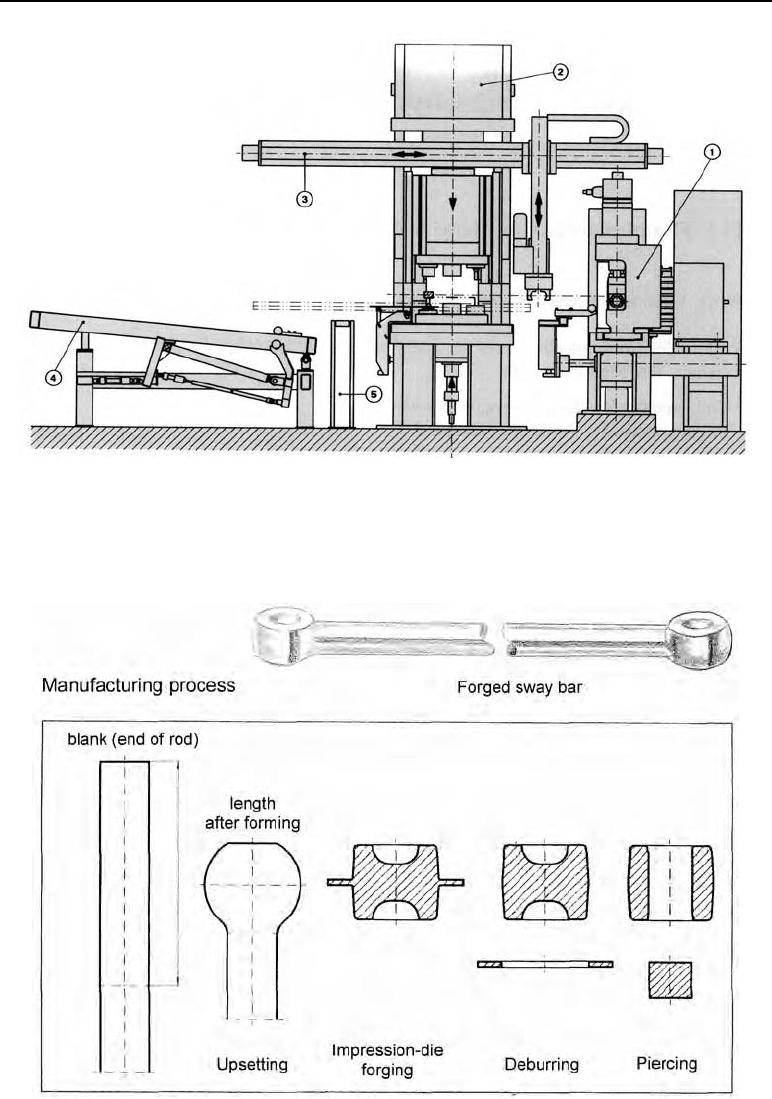
352 29 Future developments in metal forming presses and tool changing systems
Figure 29.1 Automatic forging line consisting of:
1 140 kVA electric upsetting press, 2 2000 kN press force transfer press, 3 overhead (gan-
try) manipulator, 4 storage magazine for rod stock, 5 conveyor for transporting finished
workpieces. (Illustration from LASCO Umformtechnik works, Coburg, Germany)
Figure 29.1a Sequence of operations diagram for the sway bar produced on this unit (Illustration:
LASCO Umformtechnik works, Coburg, Germany)
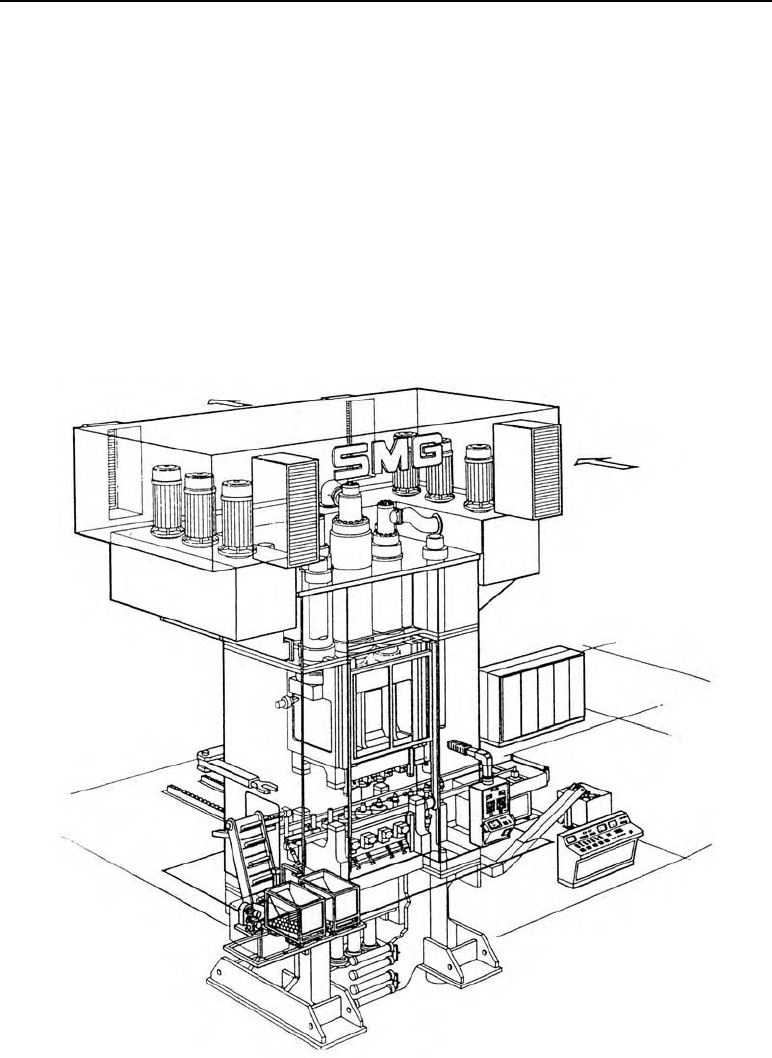
29.1 Flexible manufacturing systems in metal forming 353
29.1.2 Flexible manufacturing cells
One example of a flexible manufacturing cell (FMC) is an automatic hydraulic cold extrusion
press unit. This consists of a four-stage cold extrusion transfer press (Figure 29.2) with a press
force of 20,000 kN. Workpieces weighing up to 15 kg apiece are produced on this unit. Every-
thing runs automatically, from the stock (rod sections) feed stage and their transfer onto the
gripper system, to the output of the finished parts on a conveyor belt. The press force is also
monitored at every station.
The active tooling is changed quickly with a hydraulic tool changing arm. The whole tooling
set can be changed quickly by pressing a button.
The entire flow is controlled by a microprocessor with a memory capacity for more than 200
die sets.
Figure 29.2 Four-stage transfer press with automatic infeed and outfeed of parts and automatic fast
tool changing system.
(Illustration from Schuler SMG GmbH & Co. KG works, Waghäusel, Germany)
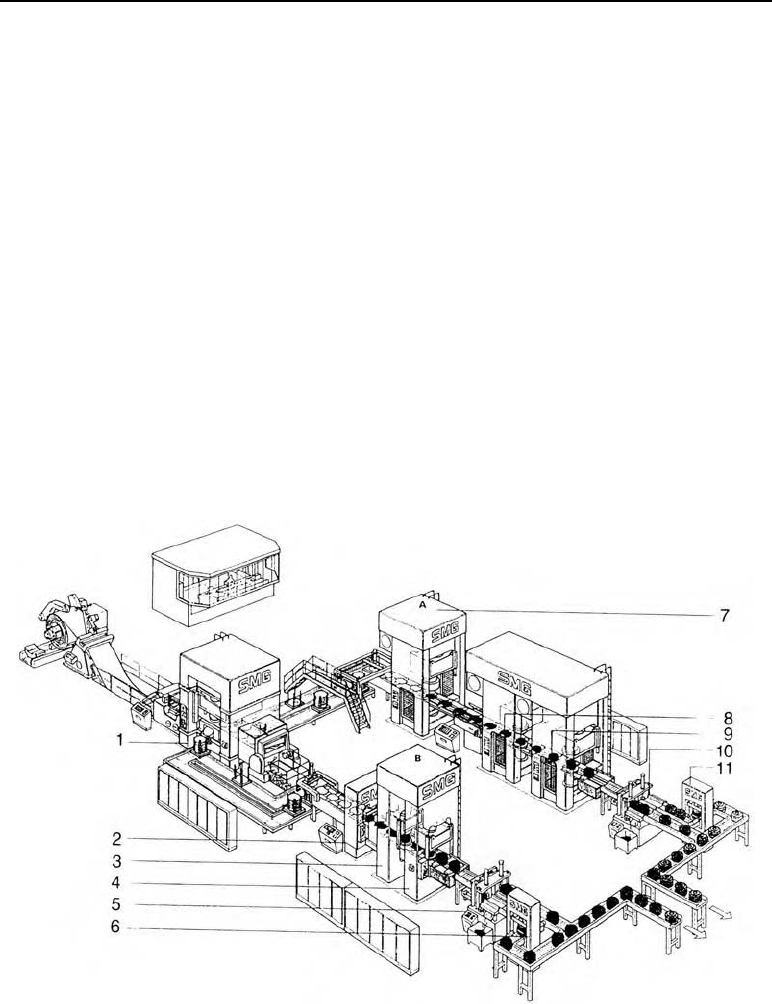
354 29 Future developments in metal forming presses and tool changing systems
As well as the four main press stations, there is also a shearing station in the side column
which means the blanks can be cut to length precisely. Tool changing is carried out fully
automatically. Only the separate tooling cartridges are changed. A tool changer handles the
tooling sets weighing up to 600 kg. These tooling cartridges are adjusted and tensioned auto-
matically in the press.
The blanks are conveyed to the press in palette trucks and there transferred to the conveyor
belt. A gripper system takes hold of the blank and takes it to the press stations. The finished
pressed parts are ejected from the press and placed on a palette truck by the gripper.
29.1.3 Flexible manufacturing system
Figure 29.3 shows a flexible manufacturing system for manufacturing gas cylinders from sheet
steel. All standard cylinder sizes on the world market are produced using this kind of unit. It
has a production capacity of 3.5 million gas cylinders per year. On this unit, 1200 cylinder
halves ( 300 × H 235) are produced per hour. Both press lines consist of:
1 stamping (embossing) press í 1 twin-column trimming machine
2 deep drawing presses 1 piercing press.
Figure 29.3 Flexible manufacturing unit for producing steel gas cylinders.
1 blanking unit, 2 stamping press, 3 and 4 deep drawing press, 5 trimming and beading machine, 6 pierc-
ing press, 7 stamping press, 8 and 9 deep drawing press, 10 trimming and beading machine, 11 piercing
press
(Illustration from SMG Süddeutsche Maschinenbaugesellschaft works, Waghäusel, Germany)
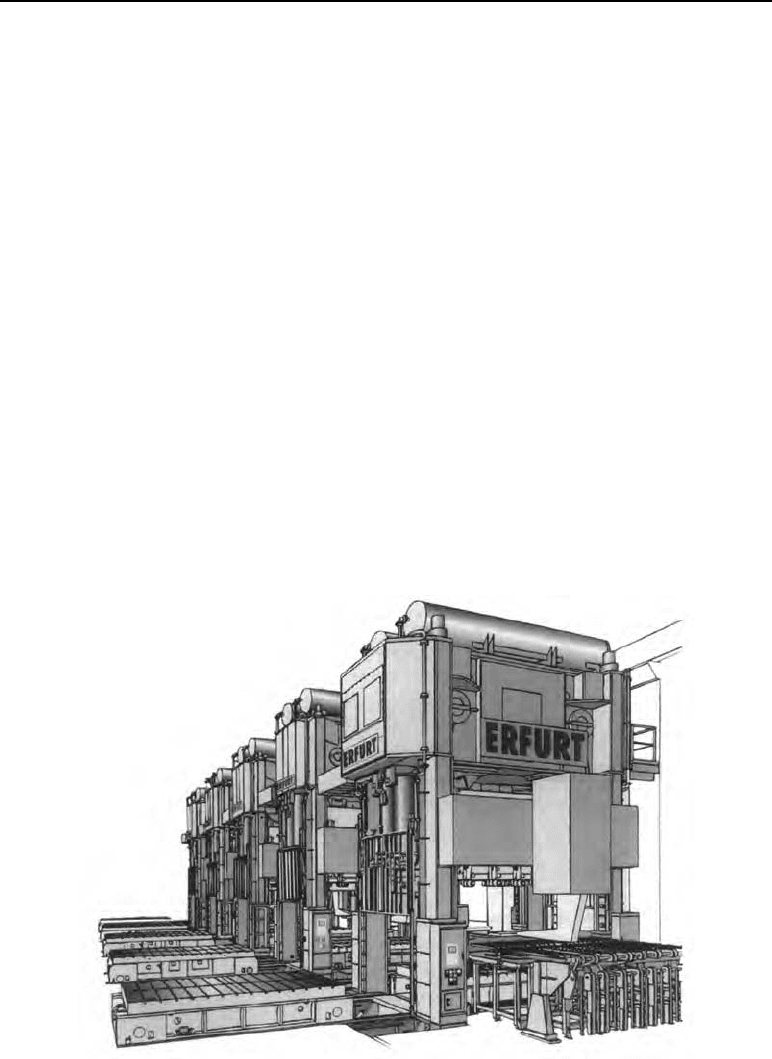
29.1 Flexible manufacturing systems in metal forming 355
The initial blanking unit provides both press lines with round blanks. They are blanked from
strip stock (1300 mm wide and 1.5 – 3.5 mm thick), stacked and then conveyed to stacking
magazines on the first press. There, gripper systems take on their transport to the press. A
gripper transfer device transports them on from press to press fully automatically. After the last
press, a roller conveyor transports them on to the wash station.
The first press in Unit B is a simple stamping press with a press force of 2000 kN; in Unit A
the first press is a combined stamping and deep drawing press with a maximum deformation
force of 4000 kN. The next presses are deep-drawing presses only, with deformation forces of
2500 kN and 1600 kN. The trimming machines have two stations each: on the left, the lower
parts of the cylinders are trimmed and beaded, on the right the upper parts are trimmed. In the
piercing press, the valves are pierced into the upper parts.
The numerical control system controls the process, monitors the tooling and reports weak spots
in the production sequence.
EMP 800 transfer press unit as a flexible manufacturing system for medium-sized shaped
sheet parts.
The demand for the low-budget manufacturing of extremely high-quality parts, both in small-
and large-scale manufacture and with the variety of parts constantly rising, has led to flexible
manufacturing systems being developed in many fields. In sheet forming, the construction of
modern transfer press units is characteristic of this development trend (Figure 29.4).
Figure 29.4 EMP 800 transfer press unit as a flexible manufacturing system
(Illustration from Umformtechnik works, Erfurt, Germany)
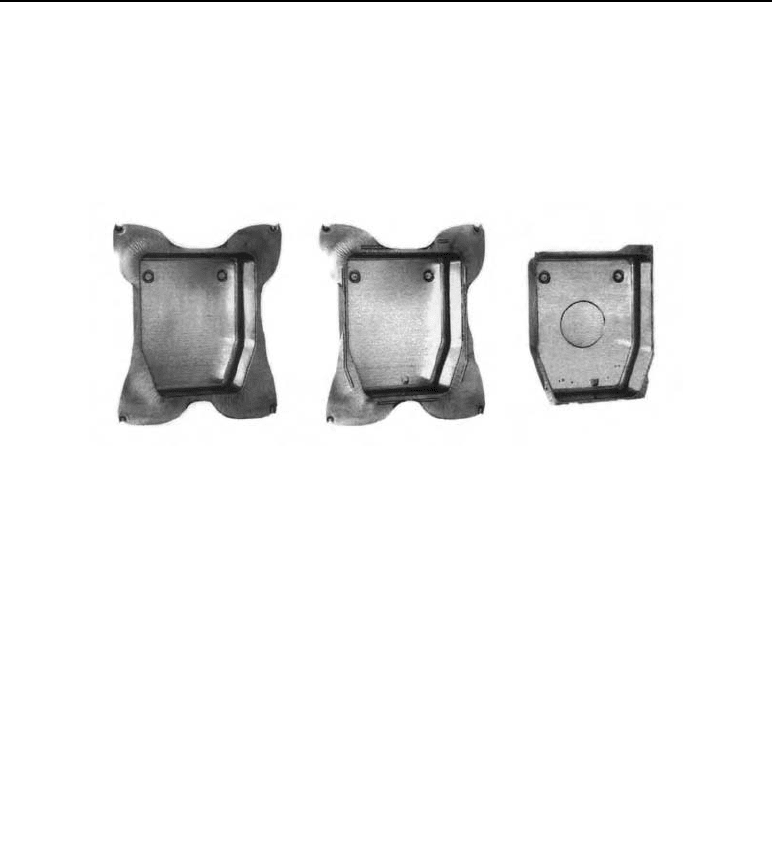
356 29 Future developments in metal forming presses and tool changing systems
The range of uses for these press units starts off with small parts, especially cup-shaped parts
whose shape includes other elements. The main uses are medium-sized press units to produce
– car body parts for automobiles and other vehicles;
– deep drawn and stamped parts for various uses (Figure 29.5).
Figure 29.5 Deep drawn part produced on a medium-sized transfer press unit (Photograph from Um-
formtechnik works, Erfurt, Germany)
As tandem presses or multi-column presses, transfer press units are used to produce large parts
such as car body parts, automobile side parts and truck body components.
Standard EMP series straight-side press as a transfer press
The basis for the flexible transfer press unit is the newly-developed series of mechanical
straight-side presses (Figure 29.6). A range of presses, built from standard modules, can be
delivered according to need. Equipped with specific modules depending upon the application,
these are used as
– universal presses
– automotive body part presses (lead and following presses)
– transfer presses and
– shearing presses.
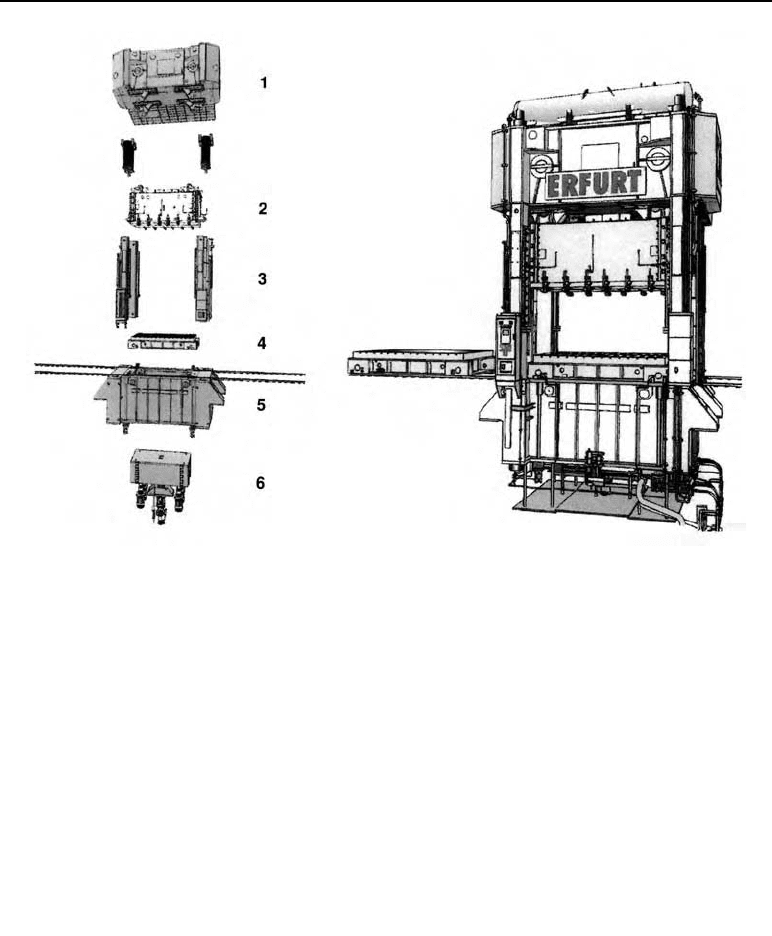
29.1 Flexible manufacturing systems in metal forming 357
Figure 29.6 EMP series modular-construction mechanical straight-side press
1 head, 2 press ram, 3 side column, 4 sliding table, 5 platen, 6 die cushion in platen
(Illustration from Umformtechnik works, Erfurt, Germany)
Hybrid drive í Application of the innovative development for deep drawing
The operational principle of a hybrid drive is based on the relative hydraulic motion of the ram
(Figure 29.7) superimposed upon the mechanical crank drive of the straight-side press. The
relative motion is effected by means of the pressure points designed as synchronised cylinders
(Figure 29.8). The braking stroke, initiated immediately before the upper die is set in place,
reduces the impact velocity of the ram with the upper die to a minimum. Towards the end of
the braking stroke and thus at the start of the deformation process, the ram velocity once more
comes into synch with that of the crank drive. Once the deformation process is completed í i.e.
at the TDC crank drive position í the relative motion of the ram is brought back to its starting
position.
For the braking stroke, a graph of velocity-related target values is established and saved in the
software. In particular, this is used to optimise the final sequence of the braking stroke. How
the braking phase is adjusted with regard to the moment of impact is a decisive factor in the
effectiveness of the hybrid drive.
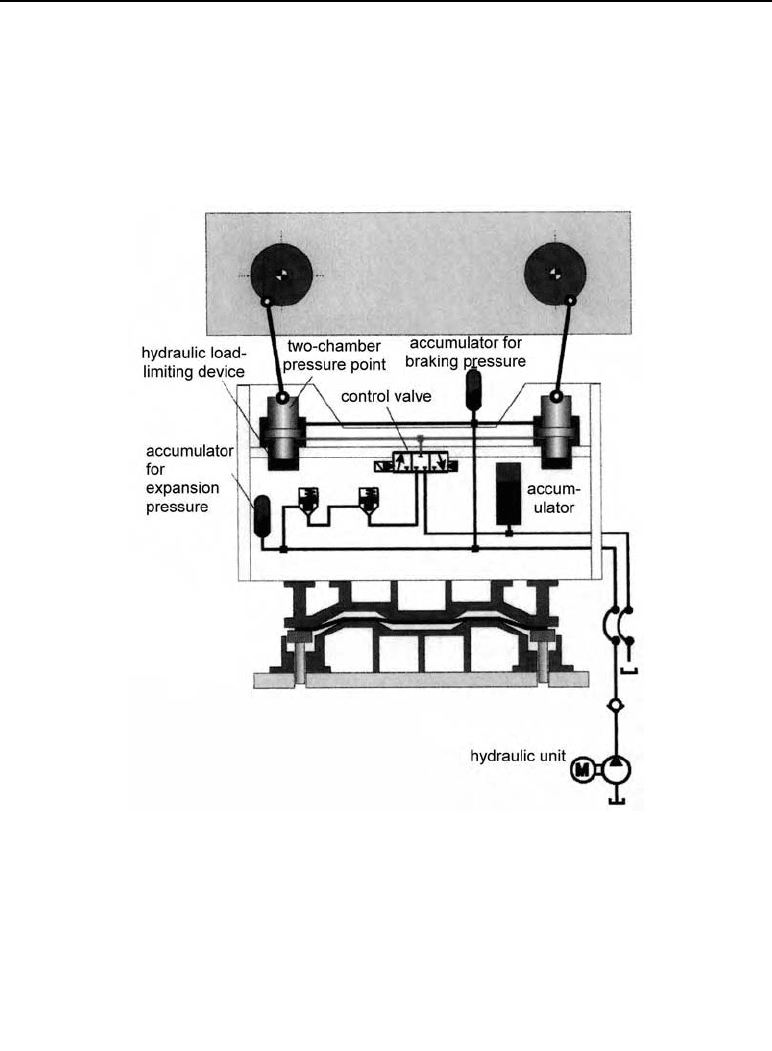
358 29 Future developments in metal forming presses and tool changing systems
Advantages of the hybrid drive:
– adapts flexibly to the geometry of the parts by adjusting the velocity reduction in each case
– usable stroke rate at maximum drawing speed í compare:
* without hybrid drive up to 16 min
–1
* with hybrid drive up to 28 min
–1
Figure 29.7 The principle of the hybrid drive (Illustration from Umformtechnik works, Erfurt, Ger-
many).
Die cushions
Using several separate die cushions makes the range of applications extremely flexible. It
means the functions of the die cushions can be adjusted to the requirements of each forming
stage. Complicated adjustments and carefully fitting the pressure bolts í as needed with single
die cushions í are no longer required (Figure 29.8).
The EMP 800 three-stage transfer press comes with a two-point hydraulic die cushion each in
stages 1 and 3 and a single-point nitrogen die cushion in stage 2.
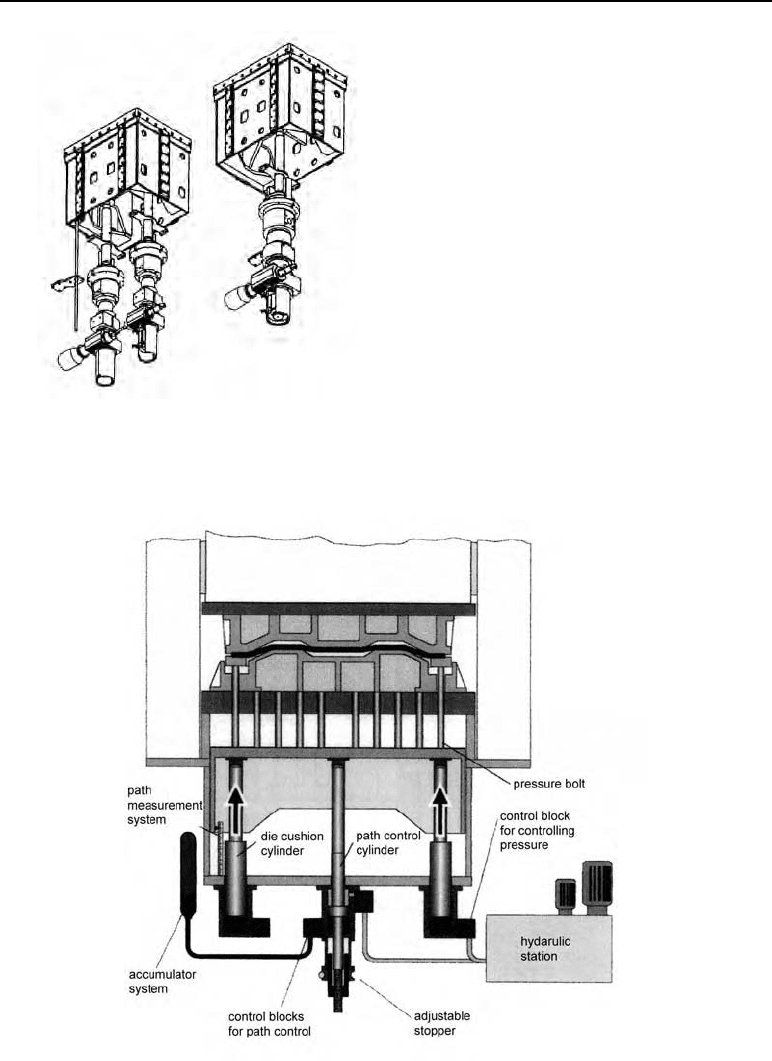
29.1 Flexible manufacturing systems in metal forming 359
Figure 29.8
Die cushion in the EMP 800 transfer press
(Illustration from Umformtechnik works, Erfurt,
Germany)
The arrangement of the individual die cushions means that all bolt types can be dealt with in
the same way as with a one-piece die cushion plate. This is also true for the three ejector cush-
ions in the ram.
Figure 29.8a Hydraulic die cushions in the platen (Illustration from Umformtechnik works, Erfurt, Ger-
many)
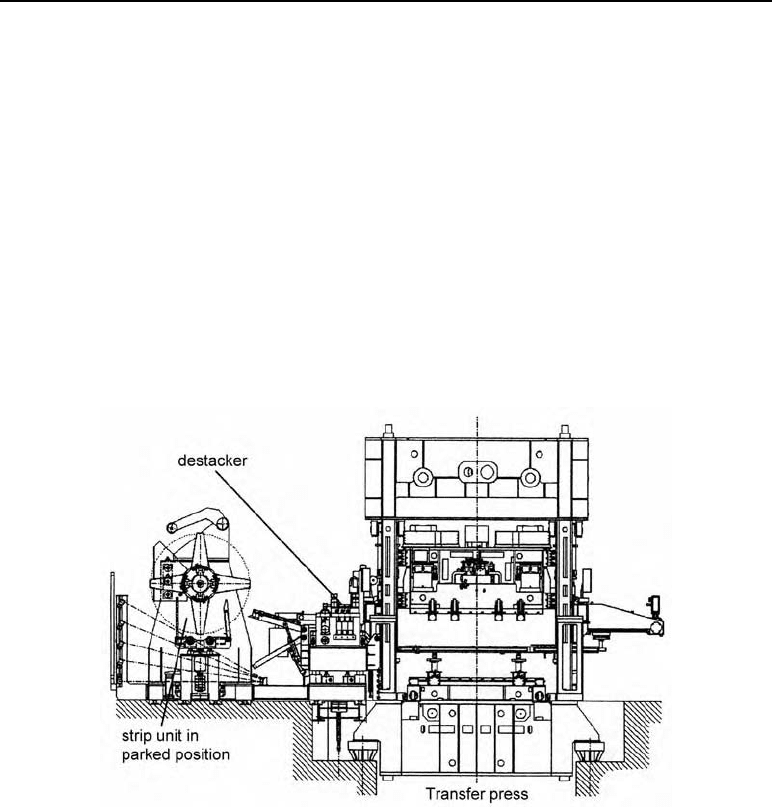
360 29 Future developments in metal forming presses and tool changing systems
As well as the standard functions such as
– preacceleration of die cushion
– free-running ejector stroke and
– controlled and prolongated ejector stroke
the flow of the forces at the pressure point can also be individually programmed.
Flexibility features
Stock feed from strip or as round blanks
The basis for flexible automation is the options for feed, from the strip unit or by means of
the blank destacker and CNC transfer. One example of the combined use of a strip unit and
a blank destacker is shown in Figure 29.9.
Figure 29.9 Transfer press with combined strip and blank feed system í side view (Illustration from
Umformtechnik works, Erfurt, Germany)
